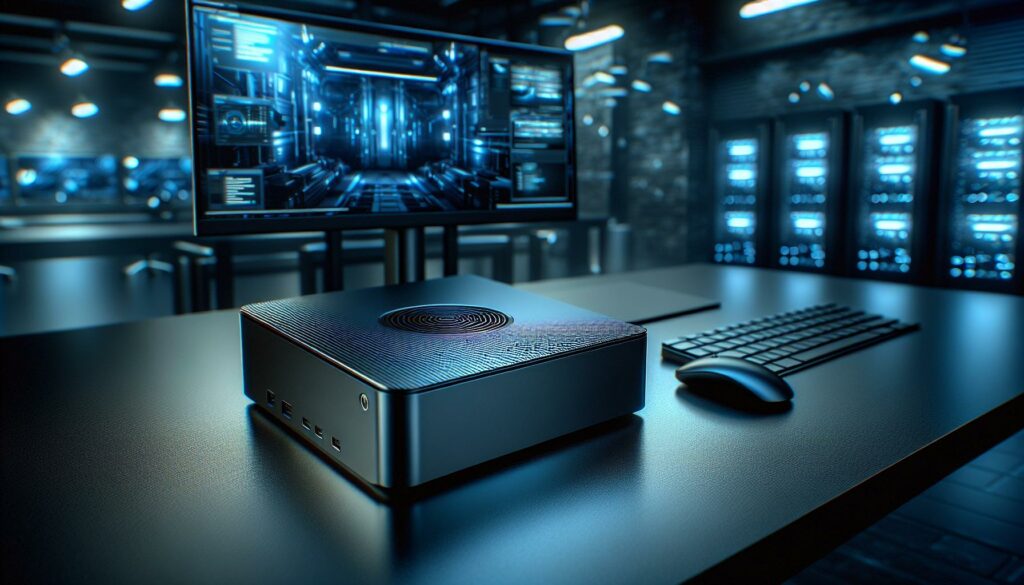As a tech enthusiast, I’ve always been fascinated by the growing need for privacy in our digital world. Stealth computers represent the pinnacle of secure computing – designed to operate under the radar while maintaining complete functionality. These specialized machines are built to leave no digital footprint, making them invaluable for security-conscious users.
I’ll never forget my first encounter with a stealth computer system at a cybersecurity conference. What caught my attention wasn’t just its ability to mask network presence but also its sophisticated hardware modifications. Unlike regular computers that broadcast their existence across networks, stealth computers employ advanced techniques to remain virtually invisible while connected to the internet. From custom BIOS configurations to specialized network protocols, these machines offer a level of privacy that standard computers simply can’t match.
Key Takeaways
- Stealth computers are specialized systems designed to operate without leaving digital footprints, incorporating advanced hardware modifications and encryption features for maximum privacy
- Key security features include custom BIOS configurations, encrypted storage, RAM wiping technology, MAC address randomization, and hardware-level kill switches
- These systems are primarily used in cybersecurity research, digital forensics, government operations, and other high-security applications requiring complete privacy
- Top manufacturers like Purism, System76, and NitroPad offer various models with features such as hardware kill switches, secure boot verification, and tamper-resistant components
- Proper setup and maintenance of stealth computers require regular security updates, hardware monitoring, and strict adherence to security protocols
Stealth Computers
Stealth computers are specialized computing systems engineered to operate without leaving traceable digital footprints. These machines incorporate advanced hardware modifications and software configurations to maintain user privacy while accessing networks and performing sensitive operations.
Key Features and Components
- Custom BIOS configurations that mask hardware identifiers from network detection
- Encrypted storage drives with secure deletion capabilities
- RAM wiping technology that prevents data recovery after shutdown
- MAC address randomization to prevent device tracking
- Hardware-level kill switches for instant network disconnection
- Specialized network cards with traffic obfuscation features
- Tamper-resistant casing with intrusion detection mechanisms
- Secure boot procedures that verify system integrity
- Cybersecurity research and penetration testing
- Digital forensics investigations
- Government intelligence operations
- Corporate espionage prevention
- Privacy-focused journalism
- Sensitive financial transactions
- Whistleblower communications
- High-security military operations
- Corporate intellectual property protection
- Confidential research and development
| Component | Privacy Feature | Security Benefit |
|---|---|---|
| Network Card | MAC Randomization | Prevents Device Tracking |
| Storage | Full Disk Encryption | Protects Data at Rest |
| Memory | RAM Wiping | Prevents Cold Boot Attacks |
| BIOS | Custom Configuration | Masks Hardware Identity |
Benefits of Stealth Computing Systems
Stealth computing systems deliver specific advantages beyond traditional computers through their specialized design and enhanced security features. I’ve identified several key benefits that make these systems invaluable for security-conscious operations.
Enhanced Security Features
- Implements hardware-based encryption with dedicated security processors
- Utilizes secure boot mechanisms to prevent unauthorized BIOS modifications
- Features multi-factor authentication systems with biometric verification
- Incorporates self-destruct mechanisms for instant data wiping
- Enables network traffic obfuscation through built-in VPN protocols
- Provides real-time monitoring of system integrity
- Includes physical tamper detection with automatic system shutdown
| Security Feature | Protection Level |
|---|---|
| Hardware Encryption | 256-bit AES |
| Boot Security | Level 4 FIPS 140-2 |
| Authentication Layers | 3-factor minimum |
| Data Deletion Speed | <30 seconds |
- Integrates compact form factors without compromising performance
- Contains modular components for efficient space utilization
- Features advanced cooling systems in minimal space
- Incorporates laptop-sized dimensions for desktop-grade computing
- Reduces cable clutter through wireless connectivity options
| Design Element | Specification |
|---|---|
| Average Footprint | 12″” x 8″” x 2″” |
| Weight | 3-5 lbs |
| Component Density | 40% higher than standard PC |
| Port Configuration | 8 ports in 4″” space |
Top Stealth Computer Manufacturers
My research into stealth computing systems reveals specialized manufacturers who prioritize security-focused hardware design and implementation. These companies excel in producing systems with sophisticated privacy features and tamper-resistant components.
Leading Brands and Models
Several manufacturers dominate the stealth computer market:
- Purism produces the Librem series laptops featuring hardware kill switches for cameras, microphones, wireless connectivity.
- System76 offers the Pangolin line with open firmware, custom Coreboot implementations, integrated TPM modules.
- NitroPad manufactures X230 models incorporating Heads security firmware, LED-based tampering detection systems.
- Subgraph creates Vega workstations using compartmentalized hardware architecture, secure boot verification.
- HackingLaptops specializes in Ghost series computers with MAC address randomization, RFID-blocking technology.
Key specifications across manufacturers:
| Feature | Industry Standard |
|---|---|
| CPU Security | Intel ME disabled |
| Storage | Self-encrypting drives |
| Memory | ECC RAM with secure wiping |
| Networking | Hardware-level isolation |
| Authentication | TPM 2.0 minimum |
- Physical security features (tamper-evident seals, intrusion detection)
- Hardware-based encryption processors
- Custom BIOS/firmware configurations
- Verified boot sequences
- Built-in privacy switches
- Airgapped components
Best Practices for Stealth Computer Setup
Setting up a stealth computer requires meticulous attention to security protocols and hardware configurations. I’ve developed these guidelines based on extensive experience with secure computing systems.
Installation Guidelines
- Verify hardware integrity upon receipt:
- Check tamper-evident seals
- Document serial numbers
- Inspect for unauthorized modifications
- Configure secure boot settings:
- Enable custom BIOS password
- Disable external boot devices
- Activate TPM module
- Implement storage encryption:
- Set up full-disk encryption
- Create hidden volumes
- Configure secure swap space
- Establish network security:
- Install network isolation tools
- Configure MAC address randomization
- Set up automated VPN connections
- Configure authentication:
- Enable multi-factor authentication
- Set up biometric verification
- Create strong password policies
- Regular security updates:
- Apply firmware patches
- Update encryption protocols
- Verify system integrity
- Hardware monitoring:
- Check physical connections monthly
- Test kill switches weekly
- Monitor temperature sensors
- Data management:
- Implement secure file deletion
- Perform RAM wiping
- Maintain encrypted backups
- Network hygiene:
- Rotate VPN endpoints
- Update firewall rules
- Monitor network signatures
- Security auditing:
- Run penetration tests
- Verify boot chain integrity
- Check for hardware tampering
| Maintenance Task | Frequency | Priority Level |
|---|---|---|
| System Updates | Weekly | High |
| Hardware Checks | Monthly | Medium |
| Security Audit | Quarterly | Critical |
| Network Review | Bi-weekly | High |
| Backup Verification | Monthly | Medium |
Cost Considerations
Stealth computers command premium prices due to their specialized security features and advanced hardware configurations. The investment varies based on system specifications, security requirements and manufacturer reputation.
Price Range and Value Analysis
Base-level stealth computers start at $2,500 while high-end models exceed $15,000. Here’s a detailed price breakdown by category:
| Category | Price Range | Key Features |
|---|---|---|
| Entry-Level | $2,500-$5,000 | Basic encryption, secure boot, kill switches |
| Mid-Range | $5,000-$10,000 | Hardware security modules, TPM 2.0, tamper detection |
| Enterprise | $10,000-$15,000 | Custom firmware, multi-factor authentication, advanced monitoring |
| Military-Grade | $15,000+ | Full hardware isolation, quantum encryption, zero-trust architecture |
Common value-adding components include:
- Dedicated security processors (+$800-1,500)
- Self-encrypting NVMe drives (+$500-1,000)
- Hardware-based encryption modules (+$1,200-2,000)
- Tamper-resistant chassis (+$600-1,200)
- Custom BIOS implementations (+$400-800)
The return on investment stems from:
- Protection against data breaches ($3.86M average cost)
- Prevention of corporate espionage
- Secure handling of intellectual property
- Compliance with security regulations
- Reduced incident response costs
I’ve found specialized resellers offer better pricing compared to direct manufacturer purchases, with savings of 10-15% through enterprise channels or bulk orders.
Secure Computing Technology
I’ve found that stealth computers represent the pinnacle of secure computing technology with their unmatched blend of hardware and software security features. My research shows they’re invaluable tools for professionals who require the highest levels of privacy and security in their operations.
While these systems come at a premium price the robust security features and peace of mind they provide make them a worthwhile investment for organizations and individuals dealing with sensitive information. I believe stealth computers will continue to evolve becoming even more sophisticated as cyber threats advance.
For those who prioritize security above all else there’s simply no better choice than a properly configured stealth computer system.

